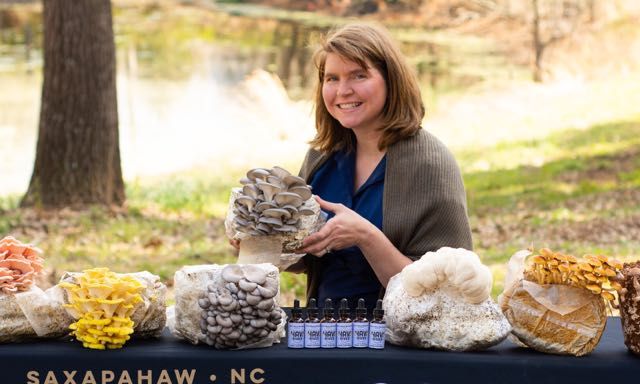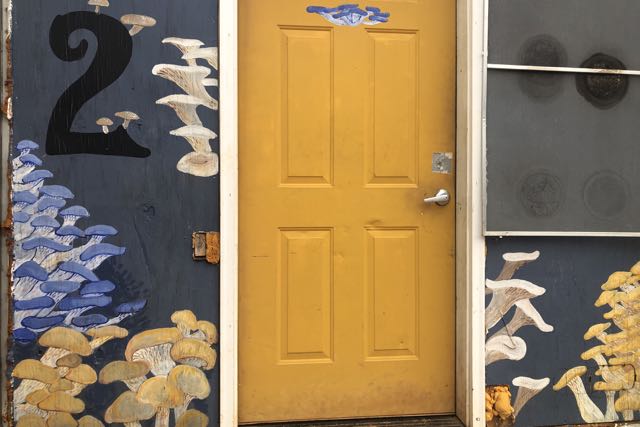
At Haw River Mushrooms, Stewart and her team grow everything from black pearl mushrooms to lion’s mane. (Courtesy Haw River Mushrooms)
In January, the New York Times named edible mushrooms the ingredient of the year for 2022. Among other trending food and drink like lab-engineered faux chicken and 1980s-style cocktails, mushrooms seem like a humble addition. But according to wild foods expert Frank Hyman, they’ve been trending for quite a while.
“I can think of maybe five times in the last 10 years where some publication has said mushrooms are the food for this year,” he laughs. “Martha Stewart declared them the ‘it’ food for 2019 – the same year that they were three movies in which mushrooms played a role as a tool of assassination.” The fears – and versatility – surrounding wild mushrooms inspired Frank to write a book, aptly titled How to Forage for Mushrooms without Dying: An Absolute Beginner's Guide to Identifying 29 Wild, Edible Mushrooms. “You're talking about mushrooms and people say ‘Oh, you could die from eating mushrooms. You better be careful out there, Frank, mushrooms are so tricky. Even experts can't tell them apart.’ Which is just not true.”
Hyman says while there are many wild mushrooms that are poisonous or simply not edible, there are just as many that can be identified and safely eaten. One of his first rules for mushroom hunters is to avoid what he calls little brown mushrooms, or “LBMs”. “Anybody who's a bird watcher is familiar with the term LBJs, little brown jobs, because there's a bazillion little brown birds,” he says. “There's a similar dynamic with mushrooms, there is a boatload of little brown mushrooms, and 99% of them are not edible or interesting in any way.” He says that time spent working to identify LBMs is time spent “not finding the equivalent of the painted buntings of the mushroom world – chicken of the woods and lion's mane and boletes and lobster mushrooms.”
He says that in general wild mushrooms should be cooked before eating, as many are toxic eaten raw or housing harmful bacteria. One exception is the beefsteak mushroom, which has the appearance of marbled steak, and the scent of lemons from bacteria-preventing ellagic and citric acids. Like the beefsteak mushroom, the cauliflower mushroom is named for its resemblance to another food. But Hyman’s book calls this type the “egg noodle mushroom.”
“It looks like egg noodles,” he laughs. “It looks like somebody had a big bowl of egg noodles, tripped over a root, and spilled it on the ground.” He says the texture is also similar to egg noodles, and that the type can “make a conversion” for those who swear they don’t like mushrooms. “It looks like such familiar comfort food from their childhood,” he says. “And partly it's the name, because that's a part of the whole eating experience – how it looks, and how it smells, how it's described.”
Hyman says that for the adventurous, wild mushrooms can also pack a culinary punch. The indigo milkie mushroom bleeds a blue milk when punctured. “Cook them, then cook up some scrambled eggs and put the blue milkies in that,” he suggests. “The blue will turn the yellow of the eggs green. So, if you grew up with Dr. Seuss, and you like green eggs and ham, here's your chance to do that.”
Hyman says that with more people exploring the outdoors over the past couple of years, the treasure-hunting quality of wild mushrooms has helped to booster their popularity. “You're not going to find the exciting mushrooms every time,” he says “But even a bad day of foraging is still a great day outdoors. And it’s gourmet food, for free, for being outdoors.”

A colorful collage on site at Haw River Mushrooms (Josephine McRobbie)
“In the beginning, we were kind of the weird crop at the farmers market,” says Laura Stewart, owner of Haw River Mushrooms in Saxapahaw, North Carolina. “I used to have to explain how to cook even oysters, and definitely things like lion’s mane, to almost every customer. And now we have quite a few who come in, and they know exactly what they want. The general education level of customers around mushrooms has gone way up. ” She notes that her business has doubled in size every year since opening in 2012. “It's a little hard to know how much is just that our business has gotten bigger, and we're getting better at what we do,” she says. “But business has definitely grown steadily, and I would attribute that in part to the U.S. kind of hitting its stride around mushroom consumption.”
At Haw River Mushrooms, Stewart and her team grow everything from black pearl mushrooms (“they’re cultivated for their stems and taste like sea scallops”) to lion’s mane (“kind of like crab meat”) indoors. Early in the process, fungal spores are inoculated in a sterilized substrate mix of sawdust and soybean hulls. The mix sits in thick plastic bags in a refrigerated trailer for a period ranging from days to months to begin growing, and is moved to a warmer grow room when the mushrooms are ready to fruit. Stewart’s team picks “ripe” mushrooms in the grow room twice a day. “Our blue oyster mushrooms double in size every 24 hours during their main growth stage,” she says. “So, by tomorrow they’re probably going to be a little further than we want them to be, today they’re a little younger than we want them to be.”
The oyster mushrooms, favored by chefs, are a mainstay at Haw River. The farm grows blue, pink, snow, golden, and Italian oysters. Stewart and her husband started Haw River as a vegetable farm, and mushrooms were just one of many crops. But it was this kind of diversity that inspired her to specialize. They’ve since moved from working out of their house to managing a 17-acre farm with a 2400-foot warehouse, and they are in the process of building a commercial kitchen. Haw River sells at 8 local farmers’ markets and runs a mushroom CSA. They also make mushroom jerky and tinctures, facilitate classes, and sell mushroom growing kits. And wholesale to restaurants is a cornerstone of their steady income. It’s part of why they grow indoors, rather than outside on logs.
“We knew that we needed to be able to provide mushrooms year round, and regardless of the weather,” says Stewart. “A lot of our chefs will put us on their seasonal menu, and our unspoken contract to them is that if we don't deliver those mushrooms, they're going to have to 86 the dish.” Laura wants to keep this part of the business thriving for local chefs. It’s here where she sees their full potential, as both an ingredient and an instrument of sustainable agriculture. “We're definitely seeing a lot of innovation with mushrooms,” she says. “How they're such a unique protein that can feed the world and be produced on such a limited footprint.”
------------
One of Haw River’s wholesale clients is The Eddy Pub. The Eddy is also located in Saxapahaw, North Carolina. It’s a former mill town outside Chapel Hill that’s cultivated a reputation as a quirky arts and food getaway. Isaiah Allen is the Eddy’s executive chef and co-owner. “We focus on sustainability and reducing our carbon footprint,” says Allen, who is also a farmer. “Minimizing waste is a huge part of what we do. And so, when I create dishes and think about how to source, I also think about that.”
This week, Chef Allen is serving a pickled mushroom conserva and a decadent mushroom and goat cheese toast. He makes the dishes with Grade B mushrooms from Haw River Mushrooms, meaning he uses a less-pretty mix of cinnamon caps, lion’s mane, and oysters. “[Some] chefs want this pristine product that comes to them top dollar and everything has to be perfectly sized, and perfectly shaped,” he says. “And knowing the agriculture side, I know how difficult that can be. As I've developed as a chef, I've kind of veered away from that a little bit. If I'm going to chop up mushrooms and saute them in a pan, I don't need I don't need them to all look the same.”
The Eddy receives mushrooms from Haw River Mushrooms in their substrate grow bags. Chef Allen trims the mushroom stems from the sawdust and soybean hull mix, and puts them through a duxelle process to create stock. “Once we've extracted everything that we could possibly get out of [the stems], they go into the buckets to compost,” he says. The substrate mix also ends up in the compost bins, and later in the compost pile at Chef Allen’s Rocky Run Farm. “I add the spent mushroom mycelium to the entire pile,” he says. “I got this light bulb moment one day, realizing that I had all these wood chips lined up and understanding what mushrooms do to wood, and how they feed on the sugars and wood. You can look at my compost pile, and it just steams like crazy in the winter.”
----------
Laura Stewart from Haw River Mushrooms has also figured out some novel uses for this used substrate material. “Being in the farming community, we realize what a privilege it is to have a product [where] its byproduct builds soil,” she says. “We've used some of our spent substrate for what we call mycoremediation projects. We have a river that runs through our property that had a lot of erosion downstream. And we took those bags and put them in coffee bags, and it helps slow the erosion, and as the water went through there it would get some natural filtration from the mycelium substrate.”
So mushrooms are versatile as a food. But Stewart says that it is uses like this that make them even more powerful - and yes - keep them trending. “We could definitely do this our whole lives and we're not going to run out of things to learn,” she says. “It's exciting. I feel like it's one of the last remaining frontiers, and that there's still so much to explore.”
Listen to this story on this episode of Earth Eats.
Music in this story by cdr255 via Soundcloud CC.













